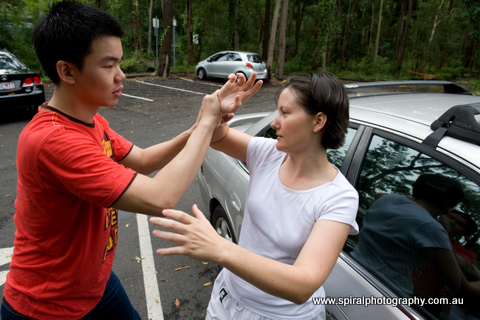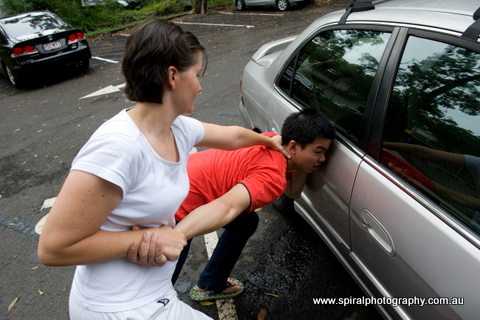The 5-step personal protection system
 The goal of Personal Protection is your own safety. That is, to stay safe or to regain a position of safety. It is not about hanging tough, engaging, fighting or payback.
The goal of Personal Protection is your own safety. That is, to stay safe or to regain a position of safety. It is not about hanging tough, engaging, fighting or payback.
With the assistance of Catherine Schnell, a Melbourne based Aikido instructor who runs a very popular Personal Safety Concepts program at her Aiki Centre, and Mike Allen, a Sydney based Target Focused Training (TFT) Instructor, Griffith Aikido has developed its own 5-Step Personal Protection system.
It consists of a series of escalated responses (below), which means you begin at preparation and move through as many of the remaining four steps below, in order, as the situation requires.
- Preparation
- Awareness
- Avoidance
- Assertiveness
- Escape
You stop when you are either in control of the situation or have managed to escape. Escape is the goal at any stage of the process, so whenever there is an opportunity to escape – take it!
1. Preparation
Have a safety plan! Develop a few simple strategies to increase your personal protection. For example, increase your own safety skills (self defence), learn to assess risk, increase your other safety resources (e.g. mobile phone, friends, family); take a friend with you, organise a lift home; use a friend and a rehearsed ruse to escape a difficult date.
2. Awareness
Awareness is your early warning defence. It takes away the element of surprise so make sure your radar is on. To increase your sense of awareness it is important to reduce distractions (e.g. headphones, mobile phones).
It is also important to monitor your environment and to increase vigilance in high risk areas. Look around you, keep your wits about you and always trust your intuition. Be wary of approaching strangers. Learn to recognise early warning signs and be attuned for the unusual. The aim is to make your self a very hard target.
3. Avoidance
 Not being where trouble resides is always the best defense. Whilst it is your right to walk in any public space at any time, there are some simple things you can do to keep yourself safe.
Not being where trouble resides is always the best defense. Whilst it is your right to walk in any public space at any time, there are some simple things you can do to keep yourself safe.
Walk away from a dispute. If there’s an opportunity to escape – take it. If you see or sense trouble walk away; if you have a bad intuitive feeling – leave; if in doubt cross the street.
Take a wide path around a blind corner, move away from bushes and avoid short cuts through lonely areas. Try to stay where other people are; don’t allow yourself to become isolated. Walk on the outside of the footpath away from darkened doorways.
4. Assertiveness
To be assertive means being confident and direct in expressing your intention. However it stops short of aggressive behaviour. Even where the situation calls for an escalated response, it should still be delivered in a calm and measured way.
The elements of assertiveness are eye contact, voice, expression and other body language. All should be neutral. Staring down, adopting a fighting stance, scowling or shouting abuse only serve to escalate the situation. However, once confronted, never take your eyes off your opponent.
It is important that you maintain an attitude of non-engagement. Therefore it is critical that you maintain distance between you and the aggressor (more than two arm lengths away) and you may have to move constantly to maintain it. While you are keeping distance an assailant will be trying to close it. Don’t allow your ego to take over your mind. Assertive non-engagement is a very powerful weapon if played out calmly.
5. Escape
In a threatening situation, stay calm and keep moving. The direction of movement is not important, provided that it is always towards safety. To escape you may have to break free of a grab or you may have to strike to distract. Pain is the distraction and punching is not the best way to strike unless you are trained. The goal is always to escape, not to fight. So don’t be too proud to turn and run. Staying safe is the goal, not looking cool.
